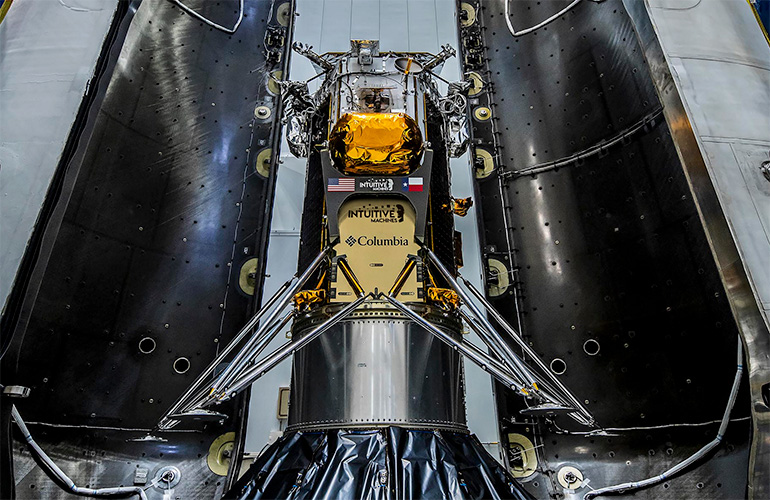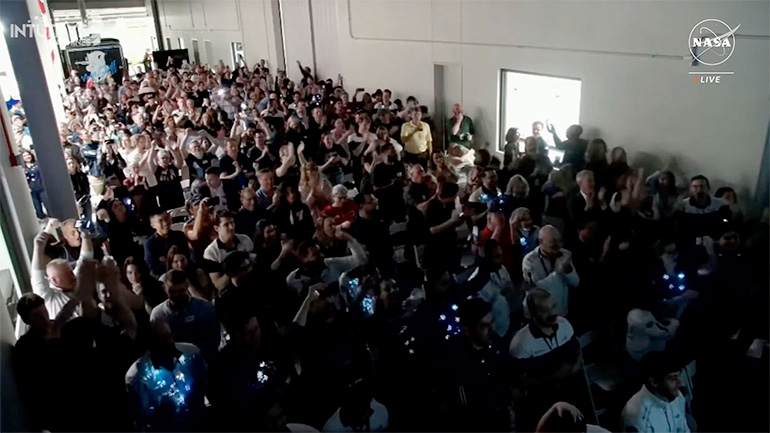Iván Hernández Dalas: Intuitive Machines’ Odysseus makes first U.S. lunar landing in 50 years

The Odysseus lunar lander loaded on top of a SpaceX robot prior to launch. | Credit: SpaceX
For the first time in 50 years, the U.S. returned to the lunar surface. While Odysseus, Intuitive Machines’ Nova-C lunar lander, was uncrewed, I am old enough to remember the first crewed moon landing of Apollo 11 back in July 1969. Today’s landing could be significant for a whole new generation of U.S. space flight fans.
Odysseus, nicknamed “Odie,” touched down on the lunar surface at 6:23 p.m. ET (23:23 GMT) and achieved a milestone as the first commercial lunar lander following NASA’s new directive to contract with private companies to engineer, manufacture, and launch spacecraft.
This mission is part of the Commercial Lunar Payload Services, or CLIPS initiative. It is a precursor to the upcoming Artemis program, whose goal is to send humans back to the moon by late 2026.
“Today is a day that shows the power and promise of NASA’s commercial partnerships,” stated Bill Nelson, NASA administrator. “Congratulations to everyone involved in this great and daring quest.”
 Learn from Agility Robotics, Amazon, Disney, Teradyne and many more.
Learn from Agility Robotics, Amazon, Disney, Teradyne and many more.
Lunar landing was delayed
The landing was delayed as flight controllers chose to make an additional orbit before starting the IM-1 Mission landing sequence. This delayed the landing by about two hours from its original estimated time. A communications blackout over the 239,000 mi. (384,000 km) between the moon and Earth led to uncertainty about Odie’s landing as its distance closed to tens of meters.
For those watching the livestream of mission control, 10 anxious minutes passed before the mission command announced that a signal had been received from the lander and that it was safely near the Malapert A crater on the lunar surface.
“I know this was a nail-biter, but we are on the surface, and we are transmitting,” said Steve Altemus, CEO of Intuitive Machines. “Welcome to the moon.”
The Houston-based company‘s lander is carrying six instruments for scientific equipment and technology demonstrations for NASA and several commercial customers. Odysseus, the product of Intuitive Machine’s $118 million contract with NASA, was launched a week ago.
It is meant to run on solar power for seven days before the lunar night begins over the polar landing spot. This will end the mission, as the lander will not survive the lunar night, which lasts approximately 14 Earth days.

Intuitive Machines employees cheered once Odie’s landing success was confirmed. | Credit: NASA
Autonomous spaceflight is hard
Odie’s success followed the recent failure of the Peregrine lunar lander from Pittsburgh-based Astrobotic to reach orbit a month earlier. Had it succeeded, Peregrine would have been the first commercial lander to reach the moon. However, a propulsion system failure doomed that lander to a fiery death in Earth’s atmosphere.
Several other countries have succeeded in reaching the lunar surface over the past couple of years, including the Vikram lander from India, part of the Chandrayaan-3 mission.
The January 2024 SLIM mission from Japan reached the lunar surface, but the lander bounced hard and ended up on its side on the lunar surface. The Chang’e 4 mission from China was the last successful lunar landing in 2019 and delivered the Yutu-2 rover onto the lunar surface.
The Russian Luna-25 mission failed in October 2023 due to a software glitch.
NASA’s last successful planetary landing mission was the Mars Perseverance rover, which landed in the Jezero crater on Mars in Feb. 18, 2021. It launched the long-lived Ingenuity helicopter.
The post Intuitive Machines’ Odysseus makes first U.S. lunar landing in 50 years appeared first on The Robot Report.
View Source
